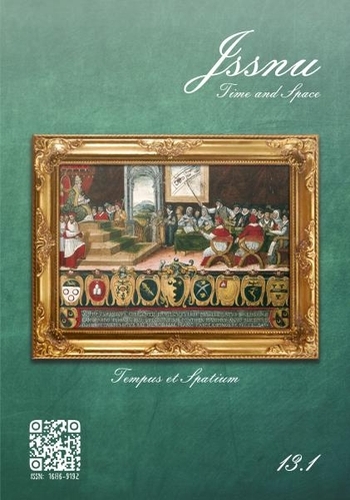Transport Infrastructure and State Formation: An Introductory Essay
Main Article Content
Abstract
This introductory essay aims to make a debate on the relationship between transport infrastructures and state. Since these kinds of infrastructure can intensify the compression of time and space, states intentionally utilize them to fulfill the status of the monopoly of legitimated violence over a certain territory and population. Meanwhile, the infrastructures enable the states to broadcast their power to the remote areas and enhance their potential of taxations and industrial development. However, investment in a network of transport infrastructure seems to be costly, so the states have to extract and appropriate economic resources from non-state actors that lead to the conflict between state and other social forces. Consequently, the conflict shapes a variety of patterns of transportation development in different spatio-temporal conditions. This essay concludes by applying case studies of infrastructure development as an issue of discussions on the fundamental characteristic of the states, interaction of states and other social actors, and the interwoven relations between national and class interests.
Downloads
Article Details
References
กฤษณ์ ปัทมะโรจน์. (2556). โครงสร้างพื้นฐานด้านโลจิสติกส์ของไทยในบริบทประชาคมอาเซียน. วารสารธรรมศาสตร์, 32 (2): 36-54.
ชาง, ฮาจุง. (2560). เศรษฐศาสตร์ [ฉบับทางเลือก]. แปลโดย วีระยุทธ กาญจน์ชูฉัตร. กรุงเทพฯ: โอเพ่นเวิร์ด.
วิภัส เลิศรัตนรังษี. (2559). รัฐกับความเร็ว: การคมนาคมในสมัยสมบูรณาญาสิทธิราชย์สยาม. ศิลปวัฒนธรรม. 37 (10): 128-145.
เอกสารภาษาอังกฤษ
Bhattacharyay, B. N. (2010). Institutions for Asian Connectivity (ADBI Working Paper 220). Tokyo: Asian Development Bank Institute. Retrieved 18 April 2017 from https://www.adb.org/sites/default /files/publication/156075/adbi-wp220.pdf [Accessed ]
Bin Wong, R. (1997). China Transformed: Historical Change and the Limits of European Experience. Ithaca, N.ew York.: Cornell University Press.
Centeno, M.A. (2002). Blood and Debt: War and the Nation-State in Latin America. University Park: Penn State University Press.
Evans, P.B., Rueschemeyer, D. and Skocpol, T. (1985). On the road toward a more adequate understanding of the state. In Evans, P., Rueschemeyer, D. and Skocpol, T. (eds). Bringing the State Back In. Cambridge: Cambridge University Press.
Fukuyama, F. (2004). State-Building: Governance and World Order in the Twenty-First Century. London: Profile Books.
......................................(2011). The Origins of Political Order: From Prehuman Times to the French Revolution. London: Profile Books.
Gilpin, R. (1987). The Political Economy of International Relations. Princeton, NJ: Princeton University Press.
Graham, S. (1998). The End of Geography or the Explosion of Place? Conceptualizing Space, Place and Information Technology. Progress in Human Geography, 22 (2): 165-185.
Hameiri, S. and Jones, L. (2016). Rising Powers and State Transformation: The Case of China. European Journal of International Relations. 22 (1): 72-98.
Harvey, D. (1989). The Condition of the Postmodernity: An Enquiry into the Origins of Cultural Change. Cambridge, M.A.: Blackwell.
Herbst, J. (2000). State and Power in Africa. Princeton, N.J.: Princeton University Press.
Hilling, D. (1996). Transport and Developing Countries. London and New York.: Routledge.
Hobsbawm, E. (1975). The Age of Capital: 1848 – 1875. London: Weidenfeld and Nicolson.
Jessop, B. (2016). The State: Past, Present, Future. Cambridge: Polity.
Maier, C.S. (2014). Leviathan 2.0: Inventing Modern Statehood. Cambridge, M.A.: The Belknap Press of Harvard University Press.
Monge, P. (1998). Communication Structures and Processes in Globalization. Journal of Communication, 48 (4): 142-153.
Phongpaichit, Pasuk and Baker, C. (1995).Thailand: Economy and Politics. Oxford and New York: Oxford University Press.
Polanyi, K. (2001). The Great Transformation: The Political and Economic Origins of Our Time with a New Introduction by Fred Block. Boston, M.A.: Beacon Press.
Robinson, R.E. (1991). Introduction: Railway Imperialism. In Davis, C.B., Wilburn, K.E. and Robinson R.E. (eds). Railway Imperialism. Westpoint, C.T.: Praeger.
Rodan, G. Hewison, K. and Robison, R. (2006). Theorising markets in South-East Asia: power and contestation. In Rodan, G., Hewison, K. and Robison, R. (eds). The Political Economy of South-East Asia: Markets, Power and Contestation 3rd Edition. Melbourne: Oxford University Press.
Skocpol, T. (1985). Bringing the state back in: Strategies of analysis in current research. In Evans, P., Rueschemeyer, D. and Skocpol, T. (eds). Bringing the State Back In. Cambridge: Cambridge University Press.
Stifel, L.D. (1973). The Growth of Rubber Economy of Southern Thailand. Journal of Southeast Asian Studies. 4 (1): 107-132.
Suehiro, A. (1996, October 18-22). Technology Formation in a Late Industrializer: The Case of the Railway Industry in Thailand (1880-1914). Paper presented at the International Symposium Southeast Asia: Global Area Studies for the 21st Century, Kyoto, Japan.
Tang, J.P. (2014). Railroad Expansion and Industrialization: Evidence from Meiji Japan. The Journal of Economic History. 74 (3): 863-886.
Teranishi, J. (2005). Evolution of the Economic System in Japan. Cheltenham: Edward and Elgar Publishing Limited.
Tilly, C. (1992). Coercion, Capital, and European States: AD 990-1992. Oxford and Cambridge, MA: Blackwell.
Trocki, C.A. (1990). Opium and Empire: Chinese Society in Colonial Singapore, 1800 – 1910. Ithaca, N.Y.: Cornell University Press.
Young, C. (1994). The African Colonial State in Comparative Perspective. New Haven, C.T.: Yale University Press.
Translated Thai References
Chang, H-J. (2017). Economics: The User’s Guide. Translated by Veerayotth Kanchoochat. Bangkok: Openworld.
Lertrattanarungsri, Wipat . (2016). State and Velocity: Transport in the Absolutist Siam. Art and Culture, 37 (10): 128-145.
Pattamaroj, Krit . (2013). Logistics Infrastructure of Thailand in the Context of the ASEAN Community. Thammasat Journal, 32 (2): 36-54.


